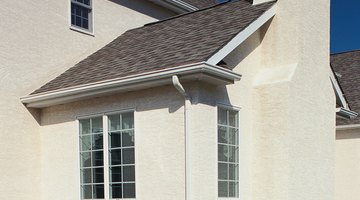The Best Siding for Exterior Chimneys
The roof of your home requires periodic inspection and repair to maintain the materials and prevent water intrusion. Another roof structure that requires care is the chimney, which can suffer damage from the elements over the years.

The exterior of the chimney may require tuckpointing or replacement of siding materials to provide the best protection against moisture intrusion into the roof and interior structural materials.
Wood Siding on Chimneys
Wood shingles are often used as siding material for chimneys, continuing from the roof area. Wood, however, can have knots that fall out or develop holes that allow water to intrude on the internal structures of the chimney, according to the Maryland Shingle website. Wood can also develop cracks that create additional water problems. These problems can be repaired by a wood-shingle roofing contractor to prevent further deterioration of chimney and roof materials. Metal flashing materials are used as transition pieces between the roof and chimney structures. Flashing materials should be inspected periodically and maintained when needed to prevent leaking problems into the home interior.
Vinyl Siding on Chimneys
Vinyl siding is generally not recommended for exterior chimney siding because of the heat that the chimney produces. Occasionally, however, it is found on chimneys installed on top of wood furring strips that provide a 1-inch clearance between the chimney and the siding. Vinyl, however, is not the best material for chimney exteriors and is generally combined with masonry materials for greater wear and fire resistance. Vinyl siding is often used on “prefab” chimneys that are made of metal.
Aluminum Siding on Chimneys
Aluminum siding provides an attractive and durable exterior siding material for chimneys. Aluminum does not rust like steel construction and matches the rest of the roofing to provide a uniform appearance. Aluminum siding can be replaced, if damaged. It does not become damaged by insects or rotting problems.
Masonry Siding for Chimneys
Generally, chimneys are made of masonry materials such as brick or stone. These materials are held together with mortar, a cement-like compound that over time becomes brittle and weak. Mortar can begin to crumble, threatening the integrity of the rest of the masonry material. Tuckpointing, or repointing, is done to restore the mortar that holds the masonry units of the chimney together. This repair is generally done by a masonry contractor, but do-it-yourselfers can also make these repairs. Brick or stone veneer provides a traditional siding material for exterior chimneys with no danger of flammability. These materials can provide a cost-effective way of restoring the appearance of the chimney exterior at a reasonable cost.
The Drip Cap
- The roof of your home requires periodic inspection and repair to maintain the materials and prevent water intrusion.
- Another roof structure that requires care is the chimney, which can suffer damage from the elements over the years.
- Wood shingles are often used as siding material for chimneys, continuing from the roof area.
- Wood can also develop cracks that create additional water problems.
- Aluminum does not rust like steel construction and matches the rest of the roofing to provide a uniform appearance.
References
Photo Credits
- Comstock/Comstock/Getty Images
- Comstock/Comstock/Getty Images
More Articles



